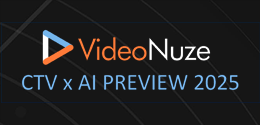-
Inside the Stream: Where Does the Disney/Fox/WBD Sports JV Fit In?
This week we look through all the buzz around the new Disney/Fox/WBD sports JV to understand the service’s opportunity and likely impact on the TV market.
Two key questions we consider: 1) How big is the target market of sports super-fans for the JV who haven’t maintained their pay-TV subscription (since sports has been a firewall to cord-cutting)? And 2) With ESPN’s own direct-to-consumer service launching in 2025, how will it differentiate itself given ESPN will also be included in the JV’s offering?
Listen to the podcast to learn more (27 minutes, 35 seconds)
Browse all previous podcasts
Subscribe to Inside the Stream
Apple Podcasts Google Podcasts Spotify Amazon Music RSSTopics: Disney, FOX, Podcast, Warner Bros. Discovery
-
Inside the Stream: Interview with Zone TV’s CEO on Block Deal
This week we interview Jeff Weber, CEO of Zone TV, which was just acquired by Block Communications. Zone TV has been operating for 22 years, and has recently been focused on streaming and FASTs. Jeff explains his motivation for the deal, the evolving market for FASTs and what’s next.
Listen to the podcast to learn more (30 minutes, 54 seconds)
Browse all previous podcasts
Subscribe to Inside the Stream
Apple Podcasts Google Podcasts Spotify Amazon Music RSSCategories: Deals & Financings, FAST, Podcasts
-
Inside the Stream: Netflix’s Record Q4 Boosted by Paid Sharing and Ads
Netflix added 13.1 million global subscribers in Q4 ’23, its best fourth quarter ever. As we discuss, the company is capitalizing on the introduction of paid sharing and a lower priced ad-supported tier. Paid sharing, which requires those who were using someone else’s login credentials to start their own subscription, has been especially effective. Netflix designed a smart strategy to eliminate this long-valued benefit. It could have become a PR nightmare, but instead has rolled out seamlessly.
Netflix said that the ad-supported tier now accounts for an impressive 40% of new subscriptions in markets where it is available. In yet another move to optimize revenue, Netflix is discontinuing its $11.99 per month Basic plan, which will drive more new subscribers to the ad tier or the least expensive ad-free tier which is $15.49 per month.
Listen to the podcast to learn more (32 minutes, 20 seconds)
Browse all previous podcasts
Subscribe to Inside the Stream
Apple Podcasts Google Podcasts Spotify Amazon Music RSSCategories: Advertising, Podcasts, SVOD
-
Inside the Stream: Was Peacock’s NFL Exclusive a Success?
NBCUniversal said that last weekend’s Chiefs-Dolphins wildcard playoff game was a big success, attracting an average audience of approximately 23 million viewers on Peacock. In this episode of Inside the Stream, Colin and I dig into key metrics of how to assess the game’s financial success to Peacock, specifically, how many incremental subscribers did the game add, and how likely are they to stay around and for how long?
Peacock reportedly paid $100 million for rights to stream the game and so getting a strong financial return is essential.
Listen to the podcast to learn more (28 minutes, 50 seconds)
Browse all previous podcasts
Subscribe to Inside the Stream
Apple Podcasts Google Podcasts Spotify Amazon Music RSS -
Inside the Stream: CES Highlights, NBCU and Disney Step Up in Ads, Netflix Growth
Big TV manufacturers made news at CES with new models and improved viewer experiences. Meanwhile NBCUniversal and Disney stepped up their ad games with announcements of many new initiatives. Separate, Netflix said it now has 23 million monthly active users, up 8 million in the past couple of months. Lastly, Amazon announced broad headcount cuts to Prime Video, MGM and Twitch.
Listen to the podcast to learn more (27 minutes, 50 seconds)
Browse all previous podcasts
Subscribe to Inside the Stream
Apple Podcasts Google Podcasts Spotify Amazon Music RSSCategories: Podcasts
Topics: Amazon, Disney, NBCU, Netflix, Podcast
-
Inside the Stream: Streaming TV Predictions for 2024
Keeping with our annual new year’s tradition, this week Colin and I offer our top predictions for streaming TV in 2024. They cover a wide range of topics including SVOD, CTV ads, TV OS, sports, FASTs, AI, cord-cutting and more. Let us know what you think - agree or disagree with us?
Listen to the podcast to learn more (28 minutes, 18 seconds)
Browse all previous podcasts
Subscribe to Inside the Stream
Apple Podcasts Google Podcasts Spotify Amazon Music RSSCategories: Podcasts
Topics: Amazon, NBA, Netflix, Podcast
-
How Advertisers Can Realize the Promise of QR Codes
Friday, January 5, 2024, 11:17 AM ETPosted by:(At the end of the article, watch a video interview with Lance Wolder and Will Richmond, Editor and Publisher of VideoNuze.)
As the advertising industry shifts from traditional linear TV to streaming, interactive ads have emerged as a novel way to cut through the clutter, leveraging the powerful personalization capabilities of Connected TV. Notably, QR codes have been gaining attention as a tool to drive measurable actions in ads. However, despite the buzz, their real-world impact remains limited. This isn’t just a QR code dilemma; it's a clarion call for a strategic shift.
Here's the thing: QR codes are known to all, yet scanned by few. The numbers don’t lie – while consumer awareness is through the roof, engagement rates have some catching up to do. It's a classic case of great potential, missed execution. Recent studies from Origin, LoopMe, and FlowCode shed light on the current state of QR code engagement. 95% of consumers are familiar with the concept of QR codes however a study from Brightline found a mere 0.02% of users scan QR codes in video ads. This begs the question: Why the disparity?
Simply put: Just because you can doesn’t mean you should.Categories: Advertising
Topics: PadSquad
-
Inside the Stream: The Top 10 Streaming Video Stories of 2023
This week on Inside the Stream we discuss our top 10 streaming video stories of 2023. As longtime listeners know, the top 10 countdown is our tradition for the final podcast of the year.
In 2023, our top picks include the rise of smart TVs, the Actors and Writers strikes, TV OS wars, CTV advertising, traditional TV’s continued fall, Disney acquiring the rest of Hulu, YouTube’s growth, SVODs drive for profitability, sports migration to online and Netflix remaining the king of SVOD. We dive into all of them and explain why each is significant. Let us know what you think of our top 10 - did we miss anything?
Listen to the podcast to learn more (38 minutes, 12 seconds)
Browse all previous podcasts
Subscribe to Inside the Stream
Apple Podcasts Google Podcasts Spotify Amazon Music RSSCategories: Podcasts
Topics: Disney, Hulu, Netflix, Podcast, YouTube



